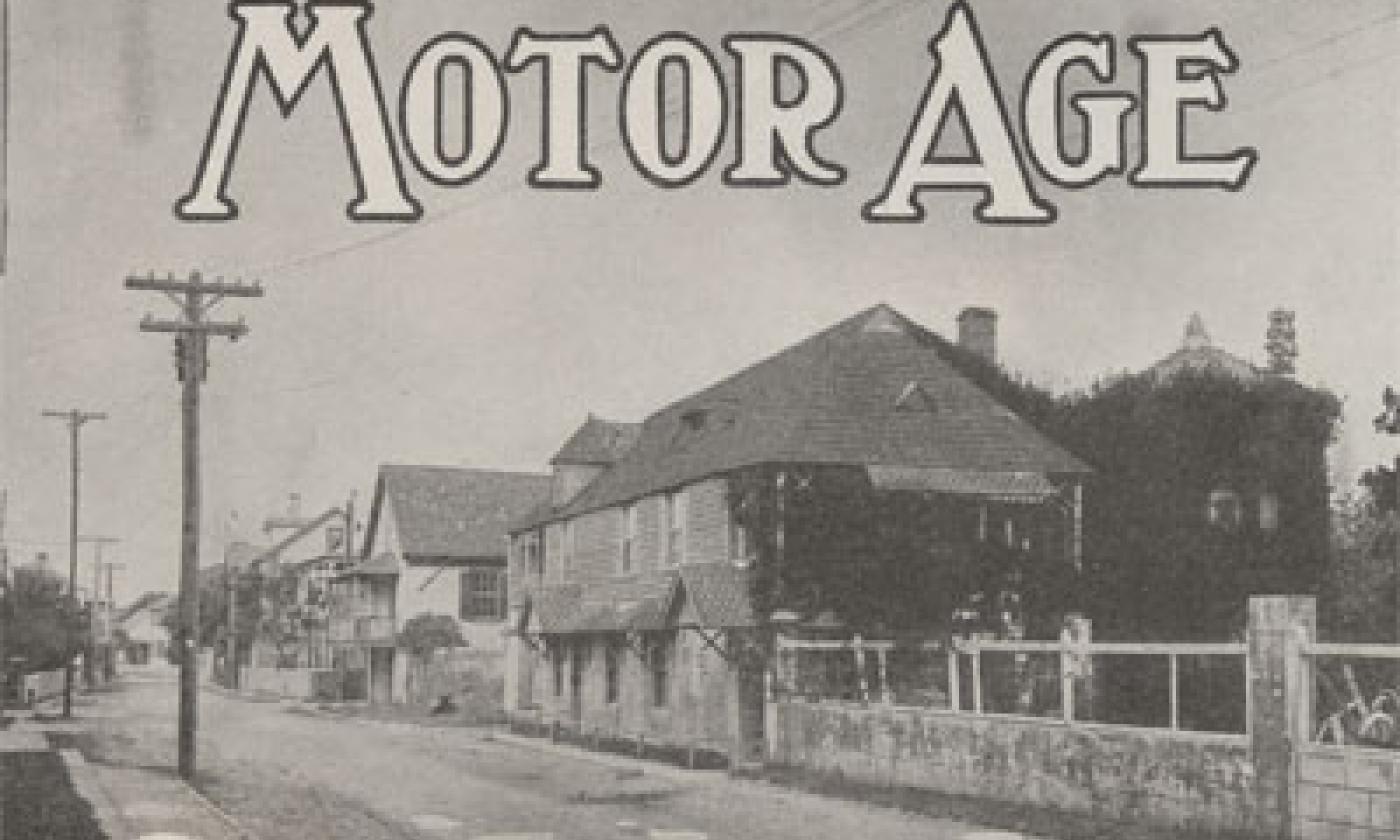
St. Augustine — Patriarch of American Cities
1915 Motor Age Magazine article about St. Augustine's history.
St. Augustine — Patriarch of American Cities
Introduction
Launched in 1899, Motor Age is the oldest automotive trade publication in the United States of America. It is still active to this day and publishes the latest industry news, intended for service professionals. This Motor Age article, entitled "St. Augustine — Patriarch of American Cities" was written by J. C. Burton and published on December 2nd, 1915. Within its artfully written text, we can learn about how people of the past thought about history and what parts of it they most valued.
***
Introduction written by Cheyenne B. Koth in the fall of 2022.

St. Augustine — Patriarch of American Cities
Florida is a realm of charming contradictions. Rival real estate agents indulge in them. Swaying palm trees hum the siesta lullabies of the tropics, while sturdy pines stand erect and defiant to meet the snow-lugging blasts of winter, which never come, with Belgium-brave resistance. Although the last of the great national frontiers, yearning for settlement and development, it can boast of having within its boundaries the first colony of the European on the mainland of North America-St. Augustine, cradle of the Spanish empire in the new world and patriarch of all American cities.
Had Ponce de Leon lived in the modern day of �Collegiate clothes for Sires of Sophomores,� which are alleged to make old men look young; of cafes dansant where still-kneed septuagenarians mimic the steps of youth and the Castles; of Broadway revues, where the exposure of bare feminine knees brings a blush of childish shame to wrinkled cheeks, St. Augustine might not be able to boast of such a distinction. For it was this intrepid but declining native of Aragon, who shipped with Columbus on the latter's second voyage to America, that gave to St. Augustine that characteristic which he could not tolerate in himself � age; a characteristic that lends to the 402-year-old city the charm of the lovable great-grandmother and none of the hideousness of the tottering, bent-backed miser.
Tiring of hearing his barber prate of hair tonics which were absolute failures as irrigation projects on barren pates and of listening to the creak of his joints as he bowed to the ladies of the court, Ponce de Leon sailed from Spain in 1512 in search of adventure and the fountain of youth. A poisoned arrow cut short his quest for adventure. He never found the magic waters which, according to the redskin quacks of Porto Rico, would turn his silver hair to brown, erase the wrinkles from his face, and free his body of rheumatism.
Although his parlous "See America First" trip was a crushing disappointment to him, the wanderings of the venerable gadabout were not in vain as far as King Ferdinand of Spain, his royal descendants and the future generations of southern tourists and Florida realty dealers were concerned. Ponce de Leon discovered the peninsular state of the Union on Easter Sunday, 1513, and put St. Augustine on the map. You will find it so written in the ancient archives of the Castilians.
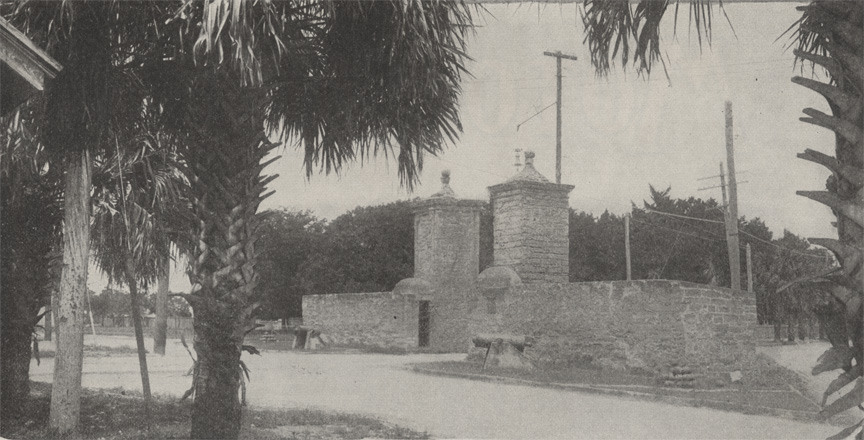
A Historical Brass Knocker
There are no visible proofs of Ponce de Leon's visit to the greybeard of American cities. The prints of his mailed shoe in the sand have not been preserved for posterity and obliging guides. There are no holes in the beach where he must have prospected for the magic aqua juventatis which, had he discovered it, would have been a Florida water much more in demand than the present product bearing that label, an eagerly quaffed potion that would have made embalming fluid a drug on the market, put undertakers and cemetery sextons out of business and received a testimonial from Lillian Russell.
The only tangible evidence of Ponce de Leon's association with St. Augustine is a brass knocker, taken from the portals of his residence in Spain to ornament the door of the Reddington house, which shares the disputed claim of being the oldest dwelling in the patriarchial city with two other antiquated structures. The knocker is genuine. A parchment, yellow with age and carefully preserved behind glass, bears testimony to its authenticity. Your only wonder is that knockers should have been used in a day when the hands of callers were encased in gloves of mail.
The achievements of Don Pedro Menendez de Aviles, who raised the royal banner of Spain over St. Augustine 52 years after Ponce de Leon landed in Florida and 44 years before the Pilgrims set foot on Plymouth rock, are far more authentic and sanguinary than those of the disappointed seeker after youth. Eager to find the waters that would make him young again and to flee approaching death, Ponce de Leon was a roving explorer. Menendez, appointed governor of the Floridas on condition that he expel the French from the land and conquer the natives, was a colonizer. It was natural that he should be. It would bea queer governor, indeed, that would not create something over which to govern. Such was the impulse that changed St. Augustine from an uninhabited stretch of sand to a lasting settlement that was destined to have a crimson and charred fight for existence.
Red, Fire-Lighted Legends
St. Augustine's early history is written in blood, the merciless massacre of the Huguenots, who had founded a settlement on the St. Johns river in 1564, by Menendez immediately upon his arrival and the retaliating butchery of the Spaniards by Dominic de Gourgues 3 years later, supplying the historians with enough red writing fluid to balance the books of the world since the day of the Creation. Thrice, before the town was a half-century old, the annalists penned chapters of defeat and destruction as the pages of their records were illuminated by crackling flames started by the firebrands of the English pirates, Sir Francis Drake and John Davis, and the invading governor of South Carolina, Moore.
Visit St. Augustine and you voice the regret, so commonly expressed, that the cinematograph was not the invention of the ancients so that all history, from the fall of Adam to the fall of Przemysl, could be pictured on the screen as the epochal episodes of the centuries actually were unfolded. The life of the old town has been a thrilling one. In its time it has seen siege and slaughter, loot and conflagration. Through its narrow streets have marched the mailed conquistadors of Spain, the bearded crews of pirate ships, the captured chiefs of the Seminoles, the blue-coated soldiers of the United States and the gray-clad troops of the Confederacy. Shot, fired from the buccaneer ships, has furrowed its beach and found a target in its forts. Galleons, flying the red and yellow flag of Spain; pirate craft, with the skull and crossbones at the masthead; yankee battleships and gunboats have ridden at anchor in its harbor. It has served four national masters � Spain, Great Britain, the United States and the Confederate States of America.
St. Augustine would make a splendid background for a historical movie. Griffith, producer of the historic film masterpieces, "The Birth of a Nation" and "Martyrs of the Alamo," should protograph it with a battery of moving picture cameras. With the ancient city as an inspiration, what a scenario Cyrus Townsend Brady could write? I can almost see the following subtitles of the various episodes of the story flashed upon the screen:
History a la Movies
"On Easter Sunday, 1513, Florida was discovered by Ponce de Leon." "Fifty-one years later, a band of French Huguenots, seeking religious liberty in the new world, settled on the banks of the St. Johns river."
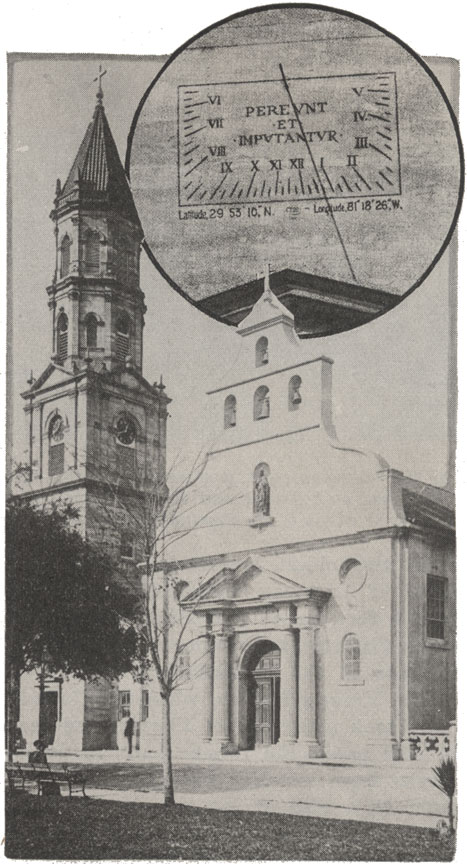
"Menendez, the bloody conquistador and colonizer, came to St. Augustine in 1565 to set up the banner of Spain and the cross of Catholicism in Florida and butcher in the name of King Phillip II and Pope Pius V."
"The booming guns of Sir Francis Drake's ships sent the Spaniards fleeing to the swamps in 1586 when the English burned the town."
"In 1665 the torch again was applied to St. Augustine, John Drake, the English pirate, attacking and sacking the town."
"St. Augustine was reduced to ashes for a third time in 1702, when the war between England and Spain spread to the American colonies and Governor Moore of South Carolina laid siege to the town and burned it."
"After 91 years of incessant labor, San Marco castle, now known as Fort Marion, was completed in 1756, and St. Augustine was secure from sea attacks."
Florida Loyal to England
"During the revolutionary war Florida remained loyal to England, and after the fall of Charleston sixty-one of the leading residents of South Carolina, believed by the British to be promoters of the conflict, were sent as prisoners to St. Augustine and treated with great indignity and contempt."
"After being ceded to England in 1763 and retroceded to Spain in 1783, Florida was purchased by the United States in 1821 and the stars and stripes were .raised over St. Augustine."
"Osceola, chief of the Seminoles, was captured under a flag of truce and brought to St. Augustine, with two of his warriors, Coacooche and Hadjo, as captives in 1835. The two minor chiefs fasted until they were thin enough to squeeze through the barred window of their cell in the old fort and escaped, but Osceola would not follow them, declaring 'The Americans have put me here, I will wait until they set me free.' "
"At the outbreak of the Civil war, the old fort was seized by the Confederate troops of Florida, but in 1862 it surrendered without resistance to Commodore Rogers, and remained garrisoned by blue-clad soldiers until the close of the conflict."
There you have the most dramatic episodes in the dramatic history of St. Augustine. If you have any imagination at all, you can supply the action. In your mind, you can cast the film play�warriors in suits of mail and uniforms of blue and grey, pirates with rags around their heads and great leather boots wrinkled about their legs, Indians dressed in blouses and knee-length skirts of gayly striped material, Franciscan friars in coarse brown robes�and collect the properties�the flags, the ships, the chains, the torches.
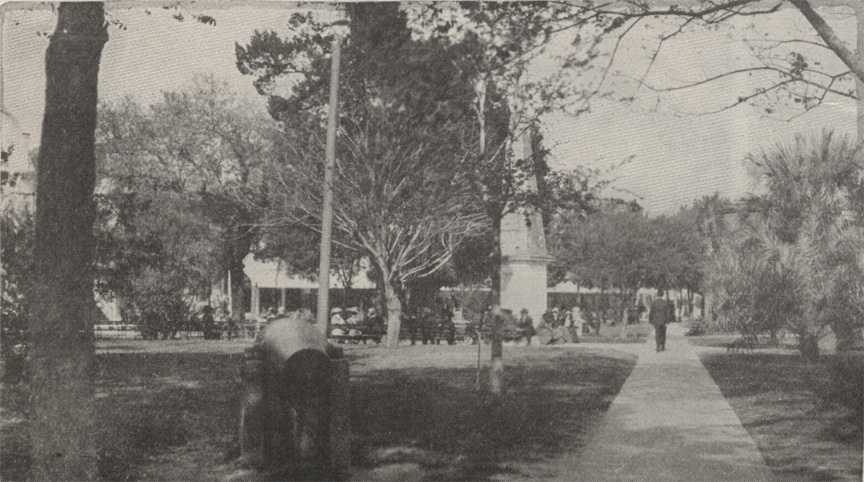
St. Augustine a Bit of Spain
Founded and settled by Spaniards and for more than three centuries a jealously guarded possession of Castilian royalty, it is no wonder that St. Augustine of 1915 is Spanish in atmosphere and architecture. It is exotic, so much like Seville that it is difficult to believe that it is an American city. The streets are narrow. You can measure the breadth of one of them, Treasury street, with outstretched arms. All the old buildings, and many of the new ones, are featured by the overhanging balconies, the pillared porches and towers so common in Spain and so foreign to the United States.
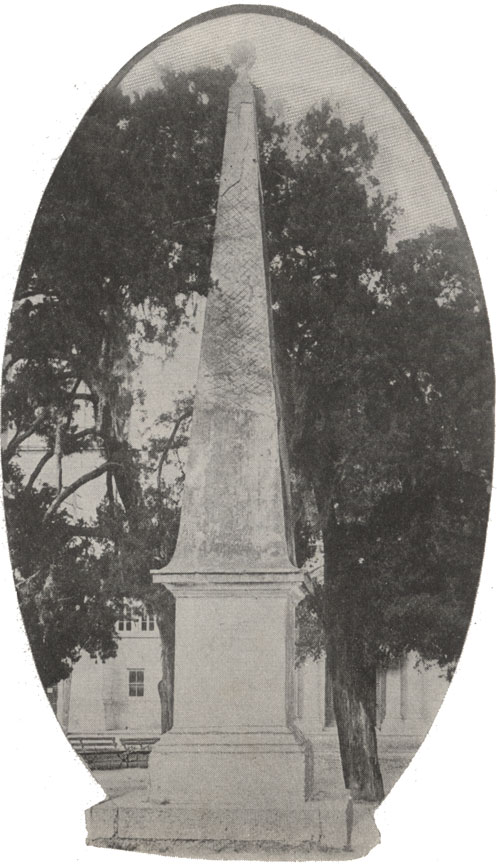
In the plaza, you instinctively listen for the tinkling bells of tiny donkeys that should be there but are not, and the imperious screech of the motor horn seems both a sacrilege and an anachronism. A portion of the native population, distinguished by their dark eyes and swarthy complexion, are descendants of the Minor-cans, who, during the British occupation of Florida, were brought from their picturesque island in the Mediterranean to New Smyrna, on the Indian river south of St. Augustine, by an unprincipled English planter, Turnbull. He subjected them to gross privation and cruelty until finally they rose in revolt, came to St. Augustine, received an allotment of land in the town and built palmetto-thatched cottages there.
Have you ever found an old book, its covers musty and green and its pages yellow and worn, in an old leather trunk in the damp cellar of an old house? If you have, you know how ancient, damp St. Augustine smells. There are walls there that look as if they would crumble to bits underneath your touch; houses that have stood for generations and defied the elements which have destroyed structures of a more youthful vigor. Although Ponce de Leon failed to find a fountain of youth there, he would be convinced that age is well preserved in St. Augustine could he return to the ancient city today.
The two oldest landmarks of the patriarch of American municipalities are the Spanish fort, called San Marco castle under Spanish rule, but renamed Fort Marion, in honor of the revolutionary war hero, General Francis Marion, when the United States took possession of Florida, and the old city gates, the former built to repel attacks from sea and the latter the entrance to a wall of logs, set up on end, which served as a protection against hostile forces making an invasion by land.

Old Fort Battle-Scarred Relic
In this day, when all the world is bewildered by German military efficiency, an inspection of the old fort at St. Augustine leads one to believe that the Spaniards of the seventeenth century were far from inefficient when it came to constructing impregnable fortifications. One shell, fired by a modern Krupp gun, probably would reduce it to debris, but 200 years ago, when it was a mark for the fire of British warships and the cannons of Governor Oglethorpe were trained upon it, the fort withstood the bombardment with a nonchalance and disdain worthy of a wealthy debutante spurning the hand of a poor suitor in a high society drama. The cannon balls made about as much impression on the thick walls of coquina as did the sponges, thrown by Roman gladiators in mock combat, on the features of the emperor, Agrippa. The leaden missiles sank into the spongy stone in the same manner that a pig's foot sinks into a wallow of mud and with less disastrous results. There was not even a squeal.
It took almost as long to build Fort Marion as it does to construct some government buildings of today-91 years to be exact. The first stone was laid in 1665, but almost a century elapsed before the engineer in charge of the work could place over the entrance the Spanish coat of arms and the following translated inscription:
Don Fernandez the Sixth being King of Spain, and Field Marshall Don Alonzo Fernandez de Herreda, Governor and Captain-General of the city of St. Augustine, Florida, and its province, this fortress was finished in the year 1756.
Although most of the work was done by slaves�prisoners from Mexico and Appalachian Indians�the cost of construction was more than $30,000,000 and the king of Spain, when asked to put his royal 0. K. on the bill, exclaimed, "Its curtains and bastions must be made of solid silver!"
The Argon monarch was wrong in his conjecture, however. The fort is built of coquina, a shell rock of natural formation that is soft when quarried but which gradually hardens when exposed to the air. The material, obtained from quarries on Anastasia island, lying in front of the city between bay and ocean, was cut in huge blocks that were ferried down the creek and across the harbor on barges and carried to their present position with crossbars.
Although I hold no belief in voodoos or ghosts, I have no doubt but that Fort Marion is haunted. If you stepped up and asked me, I could tell you of at least one thousand other places where I would prefer to spend a night, especially if the skies are shot with lightning and booming with thunder. There are many sounds more pleasant to my ears than the grating of bolts, the clanking of chains and the shrieks of tortured wraiths. I have no desire to be prematurely grey. I could spend 2 or 3 days roaming about the old castle, but a night�never.
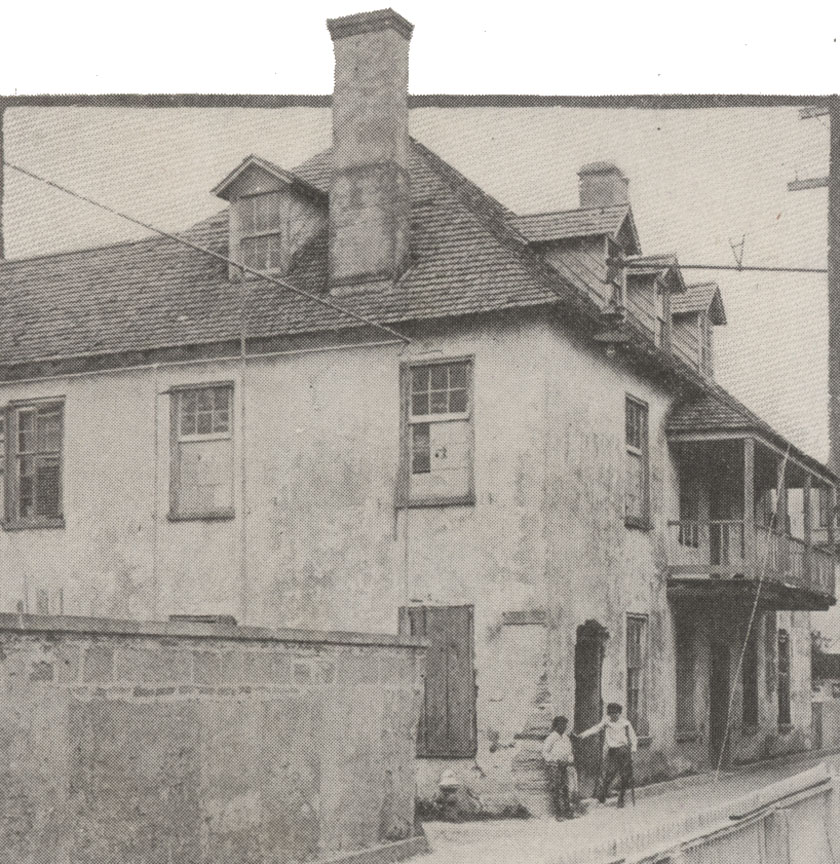
A Retreat of Apparitions
If the victims of Spanish cruelty do not pay nocturnal visits to the secret dungeons and the torture chamber, they have more good sense than ghosts are generally given credit for, and I am not taking any chances on the wisdom of departed spirits who were nailed on crosses, stretched on racks and locked in cages to die of starvation. I am willing to wager that these wraiths become restless occasionally and float up through the oubliette of quicksand, where their mangled bodies were thrown, and bounce around in the utter darkness.
Provided I were condemned to spend a night of terror within the walls of the old castle, I would make a request that I be locked up in the court room, where Osceola, with Coacoochee and Hadjo, were imprisoned, and where I might have the ghosts. of these Seminole chiefs for company. From what I can learn, they were peaceable and friendly redskins when not crossed, and you can rest assured that I would no nothing to pique them. Were my mood daring under the circumstances, I might emulate Coachoochee and Hadjo, who dug notches in the masonry at the rear of the room, climbed to the ventilator 18 feet above the floor, squeezed through horizontal bars 8 inches apart and dropped to the moat 25 feet below. On the other hand, I might become stoically patient and like Osceola, climb to the window ledge over the door and wait there until my captors came to set me free. The fates forbid that I have to wait as long as he, for Osceola, whose treacherous capture and long imprisonment is one of the darkest blots on the pages of American history, knew no day of freedom. Although released from Fort Marion, he was sent a prisoner to Sullivan's island, in Charleston harbor, where he died.
No fortress in the United States has as many legends and so fascinating a web of awe and mystery spun around it as St. Augustine's most interesting landmark. The old castle, which is the only example of mediaeval fortification on this continent, is a fine example of the art of military engineering as developed in the seventeenth century, being built on a plan of trapezium designed by Marshall Vauban, of France.
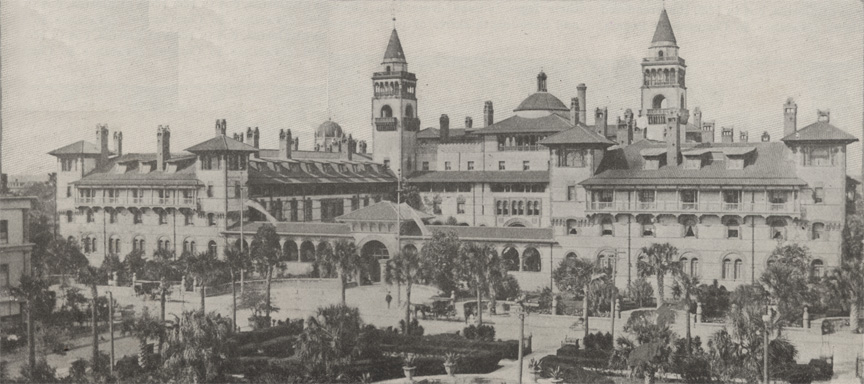
Outer Defenses of Castle
Surrounding the fort on the three land sides is an immense artificial hill of earth, known as the glacis, from the crest of which on the southeast, a bridge, formerly a drawbridge, leads across part of the moat to the barbacan. The barbacan is a fortification, surrounded by the moat and directly in front of the entrance, which it was designed to protect. A second bridge, also a drawbridge when soldiers, not tourists, besieged the ancient castle, leads from the barbacan across the wide moat to the sally-port, the only entrance to the fort.
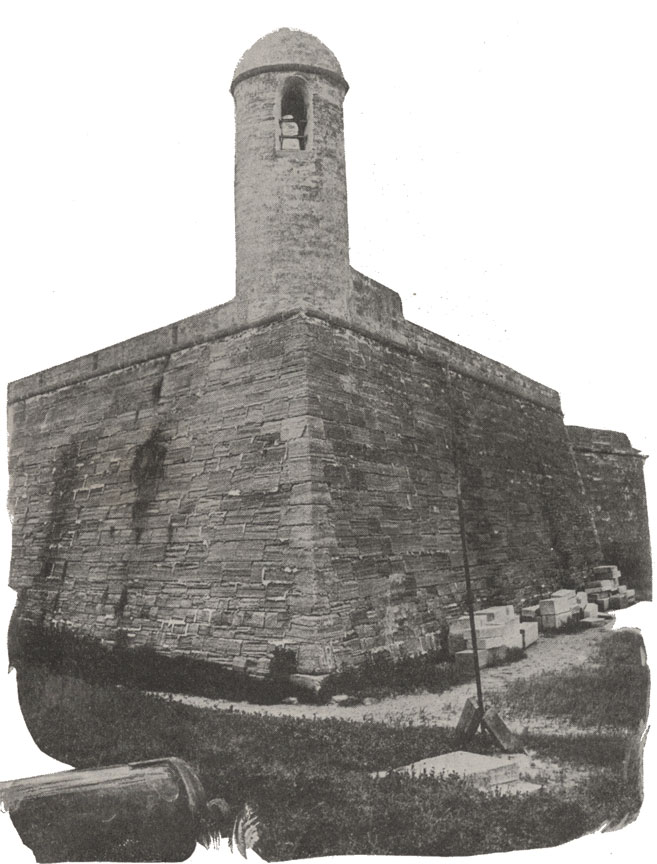
Fort Marion has four bastions, or triangular-shaped corners, known as St. Peter, St. Paul, St. Augustine and St. Charles, and four connecting walls called curtains, which are about 25 feet in height and measure 12 feet thick at the base and 9 feet at the top. On three of the bastions � are sentry towers, while on that to the northeast stands a high watch tower, where a beacon light was kept burning at night and from which the sentinel could see any portion of the surrounding country.
The terreplein, or covering between the outer and inner walls, is about 40 feet wide. Here the guns were mounted. Around the outer edge of the terreplein is a wall, 3 feet thick and 6 feet high, which was known as the parapet and pierced for sixty-four cannons. The ascent to the terreplein is up an incline plane, the ramp, originally used by artillery but recently converted into steps. The upper part of the ramp is supported by a peculiar shaped arch, remarkable for the fact that it has no keystone.

The plaza, or inner court, is 100 feet square, and the casements, with one or two exceptions, open into it. There are twenty-six casements, five dungeons and a magazine. The two casements at the right of the entrance were guard rooms and contain fireplaces. Leading off from the inner of these two rooms is a large dungeon that was used as a general prison. The casement at the left of the entrance was the commandant's headquarters, while in the southeast corner is the court room where Osceola was imprisoned. In front of this historic room is a round well, probably the first ever dug on the North American continent.
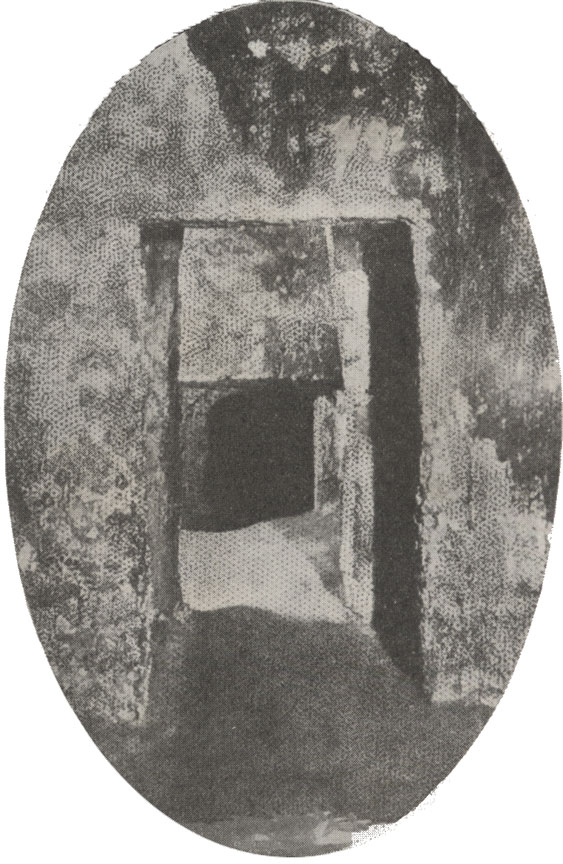
In the chapel, at the north side of the court and directly opposite the sally-port, can be seen the niches for holy water, the blocks of cedar to which the confessional was fastened, the raised stone platform for the altar and the hole in the masonry where stood the patron saint, St. Augustine. On either side of the chapel are doorways through the iron bars of which the prisoners could hear mass before being executed. The iron bars were necessary, as at that time a doomed man could claim the right of sanctuary if he gained entrance to the chapel and knelt at the altar.

Grim Reminders of Executions
At the eastern side of the fort is a hot shot oven, constructed by the United States government in 1835. Here cannon balls were fired to a white heat to be hurled by mortars at the wooden vessels of an approaching enemy. In the walls of the old castle, both front and back of the hot shot oven, can be seen the bullet holes where prisoners were executed by the Spaniards when the captors were in a too merciful a mood to condemn their victims to the black torture chamber.
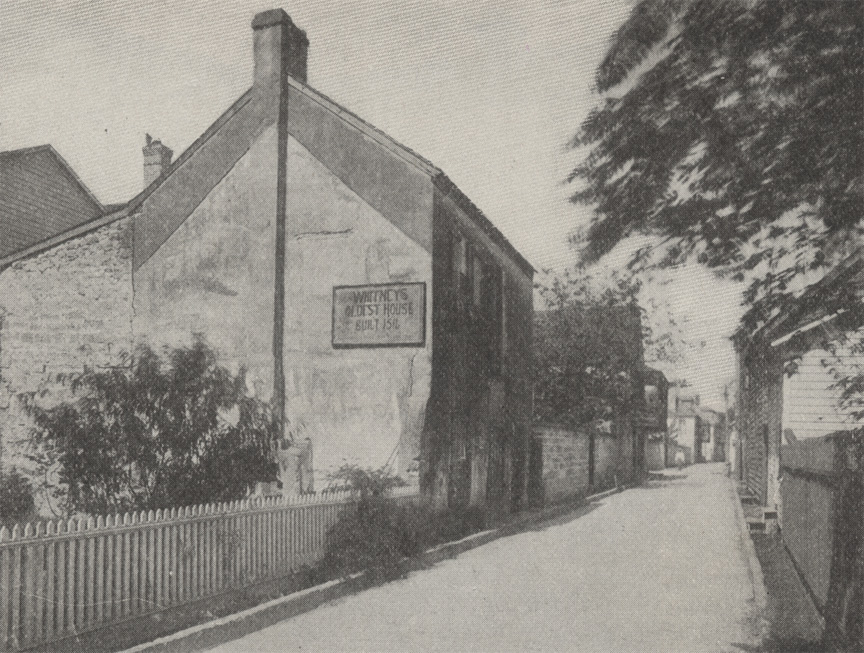
St. Augustine has another fort older than historic San Marco castle but not as famous. It is situated at the southern end of Anastasia island on Mantanza inlet and once guarded the sea approach to the town from the south. It no longer is a defense; it is a ruin. Its walls have been scarred and cracked by the sledges of time. Seeds have been blown into its crevices by the winds of past centuries and trees and shrubs have taken root there. It was built on bloody ground for it was on Anastasia island that Menendez took the Huguenots captives and slaughtered them in the name of religion, "not as Frenchmen, but as Lutherans." At the northern entrance of the town and at the foot of the main thoroughfare of St. Augustine, St. George street, stand the pillars of the city gates as cherished landmarks of a brave past and conspicuous relics of the elaborate system of fortifications that once defended the patriarch of American municipalities. The drawbridge, once trod by the mailed feet of the conquistador, and the great gate, which in times past shook with the shock of assault, are no more but the two square colSumns of coquina and the barred-doored guard houses have been preserved for tourists to scratch their names upon.
The Gay Days of Old
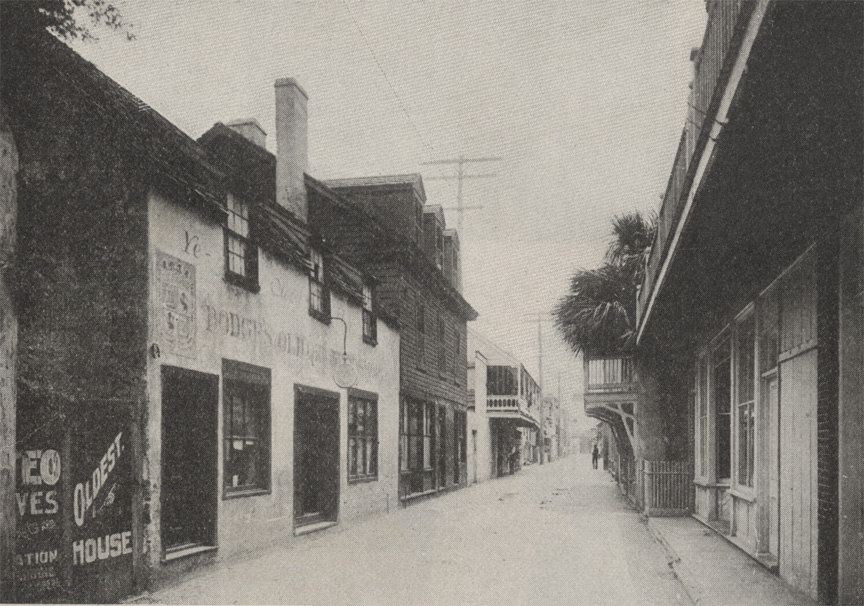
To appreciate the city gates to the fullest, you must have imagination. You must go back three or four centuries and imagine that you are a belated wayfarer. It is night and dark. A tropical storm is raging. The bridge is raised and the gate is closed. The guard, sheltered from the driving rain and sardonically toasting his heels by the fire of the sentry box, first challenges your approach and then orders you to remain without until morning. Without what' Without a rain coat and food and lodging. It was verily a gay life in those days when St. Augustine erected barriers to check the entrance of the tourist, were he friend or enemy, bent on sight-seeing or thirsty for conquest.
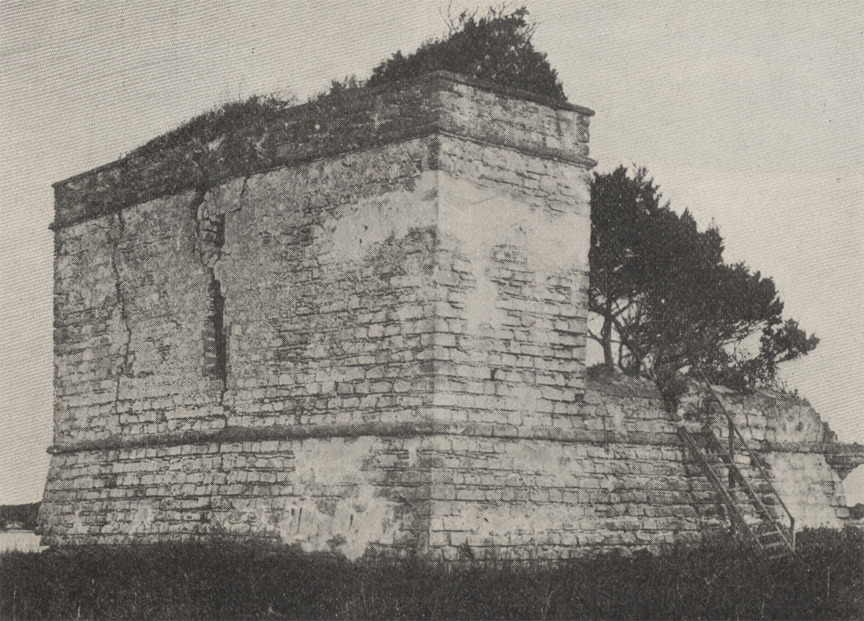
Although St. Augustine boasts of three oldest houses — Reddington's, Dodge's and Whitney's — I honored but one, Reddington's, with my inquisitive presence and found it an old curiosity shop worth far more time than I was able to give it. According to the caretaker, a white-haired, wrinkled-faced woman endowed with that charm of age befitting a caretaker of such an old house, the dwelling was built in 1665, the year that work was started on Fort Marion, and was used as a monastery by Franciscan friars. A short time afterwards, it became the residence of the Spanish governor and was occupied by him and his descendants until the middle of the nineteenth century when it was purchased by a philanthropic resident of St. Augustine and made a repository for a most interesting collection of antiques, all of them genuine and many of them purchased by collectors and placed in the old house after being exhibited at the World's Columbian exposition at Chicago.
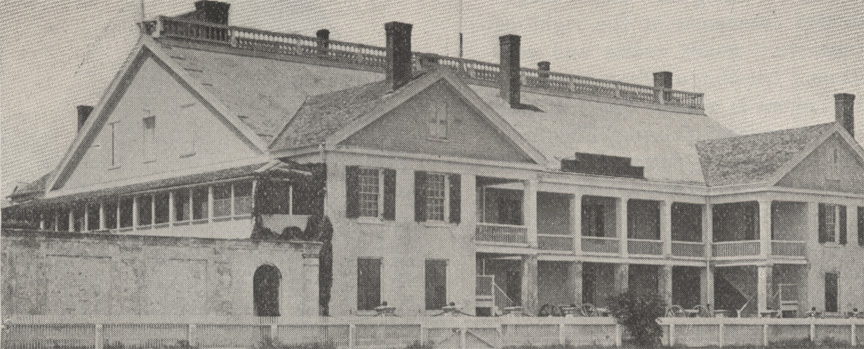
You are rubbing elbows with history as soon as you place your hand on the brass knocker of the door. It's metallic rapping once heralded the arrival of a visitor at the portals of Ponce de Leon's castle in Spain. The soles of your unholy shoes shuffle over a stone floor paced by the sandaled feet of meditative monks 250 years ago. The dusty beams of the ceiling were hewn from cedar logs by captive Indians more than two centuries back. The swinging doors between the rooms once hung at the entrance of cabins on Spanish galleons.
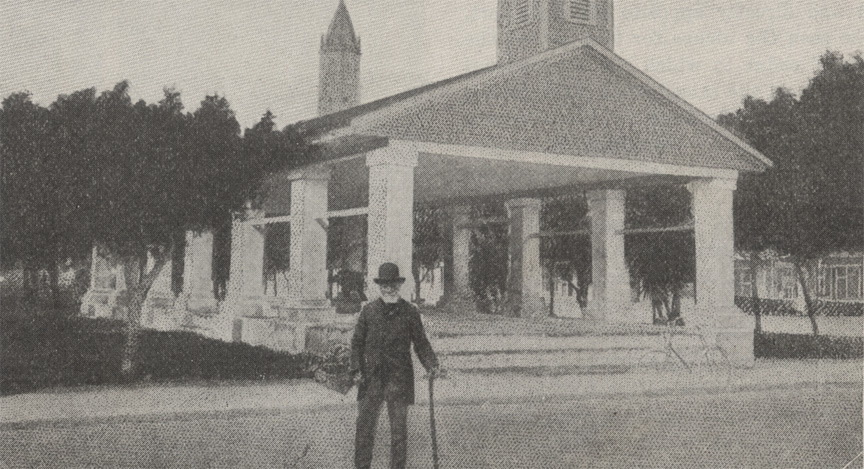
Each of the antiques stored in the old house has a history. You can sit on the bed of Maria Theresa, the German empress and mother of Marie Antoinette, and wish that you had invested in Bethlehem steel or other "war brides." If you are superstitious and believe that wishes come true when made on the couch of a queen, you immediately cease to envy John D. Rockefeller and other members of the Awful Rich. You rub your hand over the red plush top of Napoleon's council table, the gift of Marshall Ney to the child of destiny, and look in your pocket for an envelope in which to preserve the dust that you have filched from furniture of such historic associations. You drop a copper penny, of a mintage of the '30's, in the slot of a tobacco-vending machine just as Henry Clay did almost a century ago and wonder for what brand of weed the great defender of state's rights wrote testimonials, if he endorsed Tuxedo as do Christy Mathewson and Francis X. Bushman today.
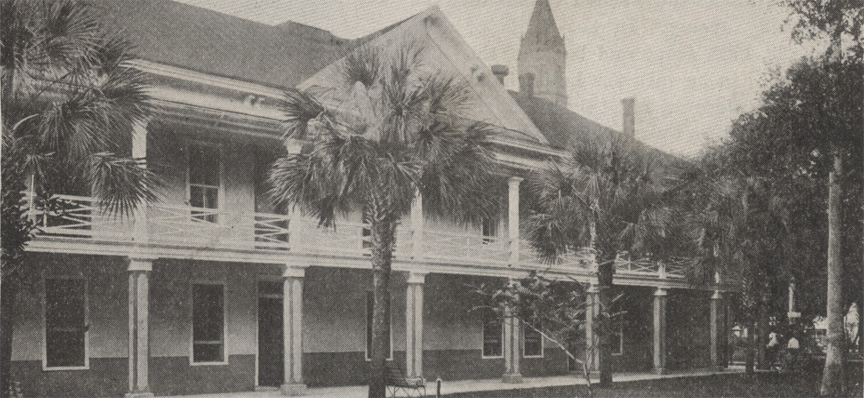
Nearby Reddington's old house is the state arsenal and a former barracks, a two-story, rambling, white structure featured by a long porch across the front and supported by pillars. This was once the retreat of devout priests and not a storehouse for arms and ammunition or a garrison for English and American troops. Across the street is the parade ground, now a park but once the scene of martial maneuvers, and a short distance south of the arsenal is a military cemetery, conspicuous because of three low pyramids, the tombs of officers and soldiers that lost their lives in the Seminole war, and a memorial shaft erected in memory of the 107 men that marched with Major Dade in 1835 to be massacred by a band of Indians lying in ambush. All but three of Dade's command were killed.
Built Around a Plaza
Like all towns of Spanish origin, St. Augustine is built around a plaza, a public park of tropical shrubbery and palm trees in the center of the town. Here is the governor's palace, now used as the postoffice; an open structure that is alleged to have been once a slave market but probably serving for the sale of fish, meats and vegetables and not human beings; and a white coquina monument, surmounted by a cannon ball, that was raised in honor of the adoption of the Spanish constitution in 1812. Two years later, King Ferdinand VII, repudiated the Castilian magna charta and ordered all the commemorative shafts torn down but because of the distance of St. Augustine from Madrid, this monument in Florida alone escaped destruction and remains a unique and curious relic of an almost forgotten incident.
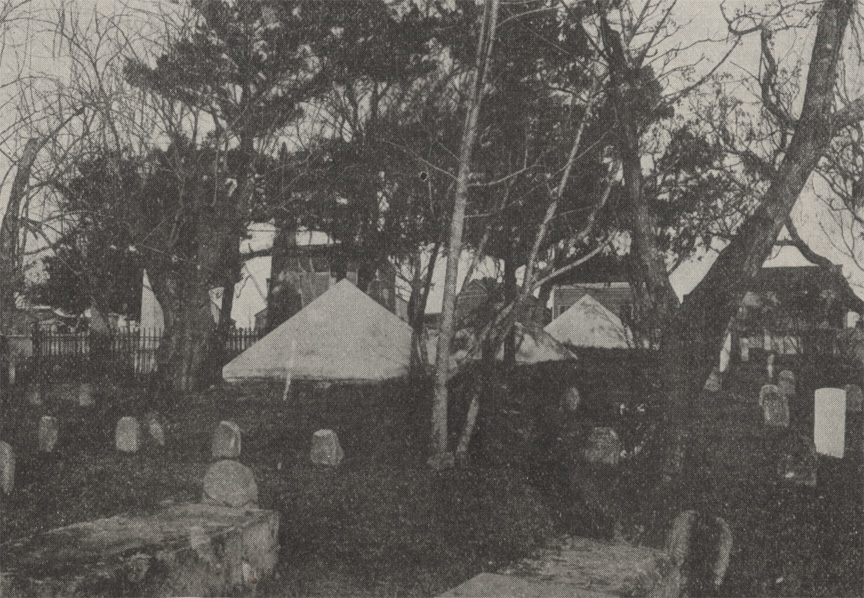
Among other places of interest for the tourist are the old Spanish cemetery on St. George street, where the moss-festooned trees solemnly bow their branches over cracked vaults, tombs and pyramids and broken grave stones; the old cathedral, built in 1701 of coquina that defied the flames which partly destroyed the church in 1885, opposite the plaza; and the Memorial Presbyterian church, built by Henry M. Flagler, the pioneer in Florida's modern development.
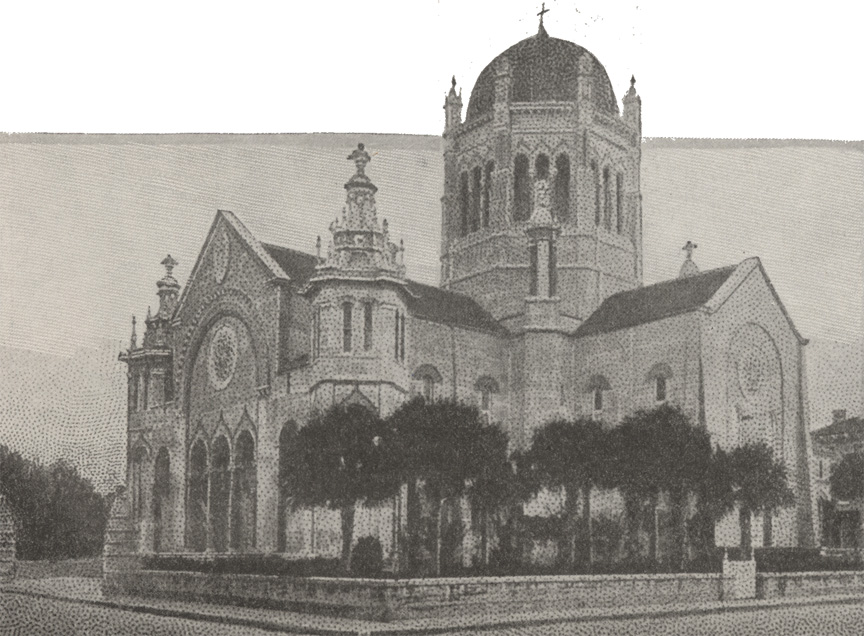
The Memorial Presbyterian church has little history, but as far as I know, it is the most ornate structure of its kind in the country. Although I am no authority on architecture, it seemed to me to be a harmonious blending of the Egyptian, Grecian, Roman, Moorish, Italian and English types-a sort of international potpourri of design, a great dome surrounded by minarets and towers, a wonderful conglomerate of fantastic gargoyles that almost defy description. If it were built in the shape of a cross, Aladdin's palace must have been something like it. The architects, Messrs. Carr�re and Hastings, would be doing me an especial favor if they would tell me where they found the magic lamp of the Arabian Nights' tale. I am thinking of building a modest bungalow.
I have only two faults to find with St. Augustine. In the first place, it is fearfully wet when it rains. After wading through water over the tops of my shoes and walking picket fences to escape an untimely death from drowning, the conviction struck me that Noah must have made the city his watering place after the floods had receded. After spending 40 days and 40 nights in the ark, that venerable mariner could not have been homesick for the sight of water had he visited St. Augustine the day the fates directed me there.
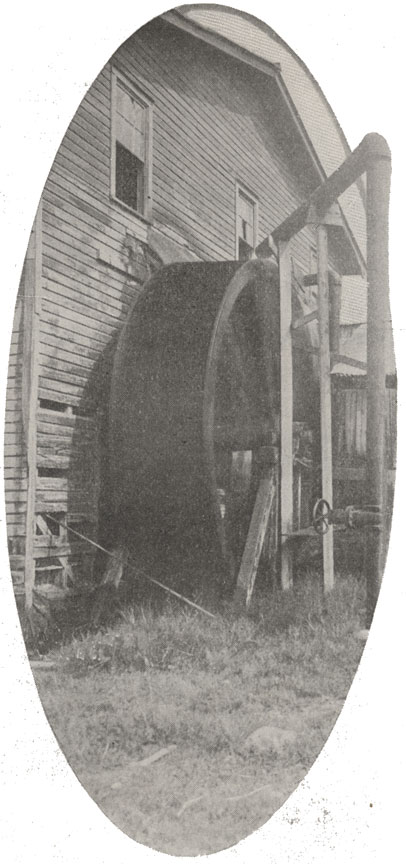
My second criticism is that St. Augustine has not been properly staged. It needs the finishing touches of a Belasco to be ideal. It lacks a bull ring and senoritas, with mantillas over their heads, walking in the plaza. The policemen should brandish machettes, not night sticks, and smoke cigarets while on duty. These recommendations are made gratis to the Civic Improvement League of St. Augustine. Aside from these faults, all fancied perhaps, St. Augustine is a wonderful city, wonderful because of its age and its historic association with four dead centuries.
***
Bibliographic Citations for this Resource
APA: Burton, J. C. (1915). "St. Augustine — Patriarch of American Cities." Motor Age, XVIII (23). Accessed via VisitStAugustine.com.
MLA: Burton, J.C. "St. Augustine — Patriarch of American Cities." Motor Age, XVIII (23) (1915). Accessed via VisitStAugustine.com.
Chicago: Burton, J.C. "St. Augustine — Patriarch of American Cities." Motor Age, XVIII, 23 (1915). Accessed via VisitStAugustine.com.

